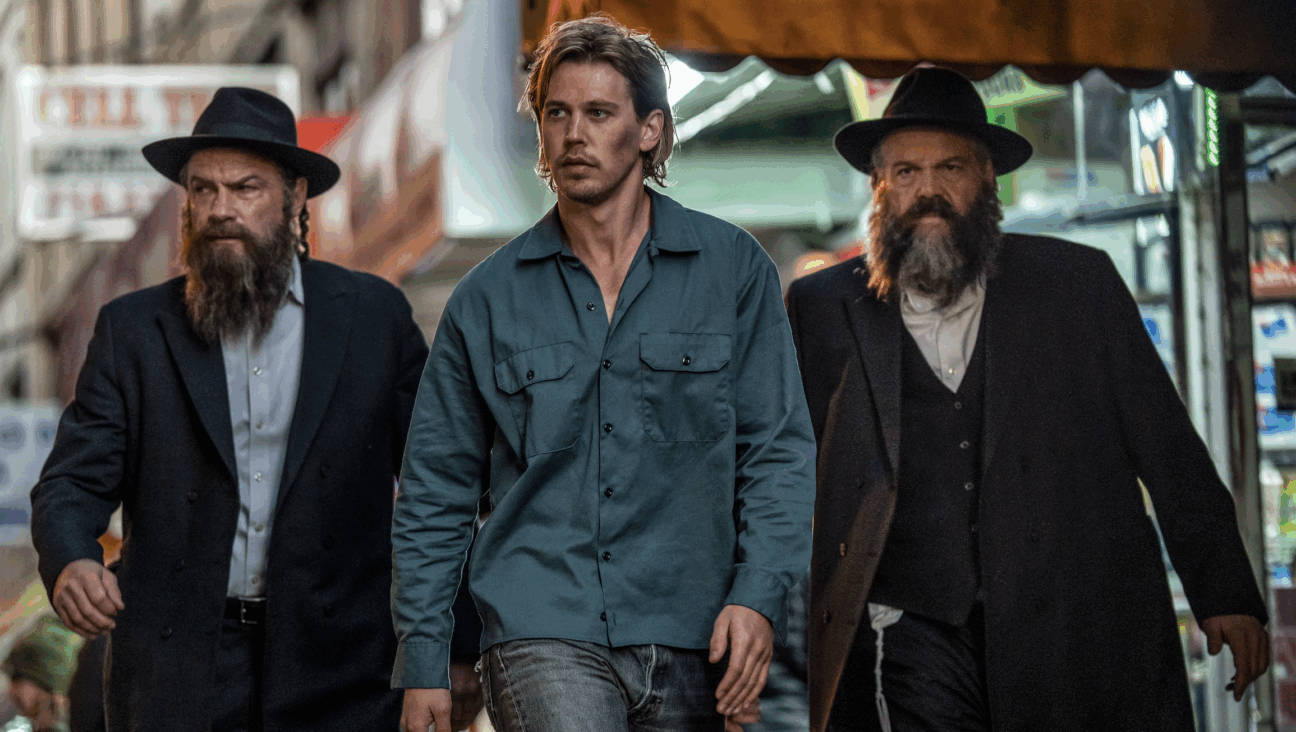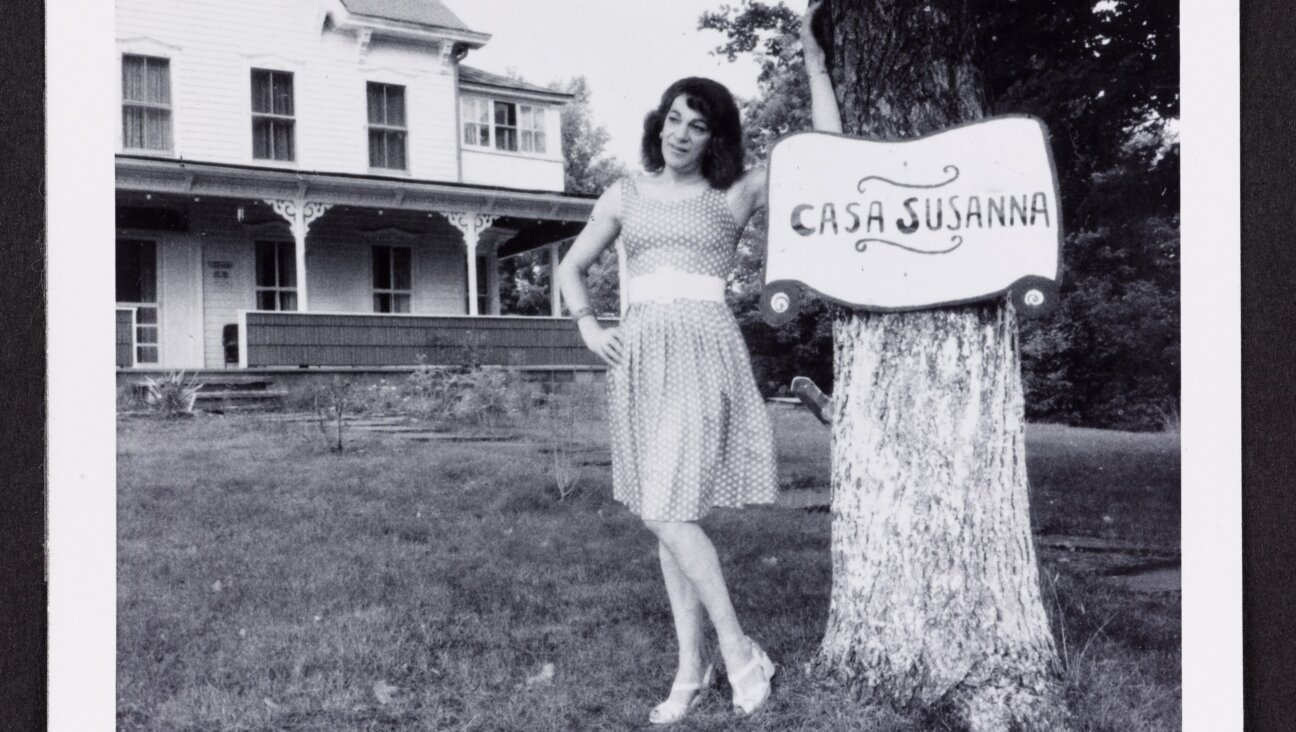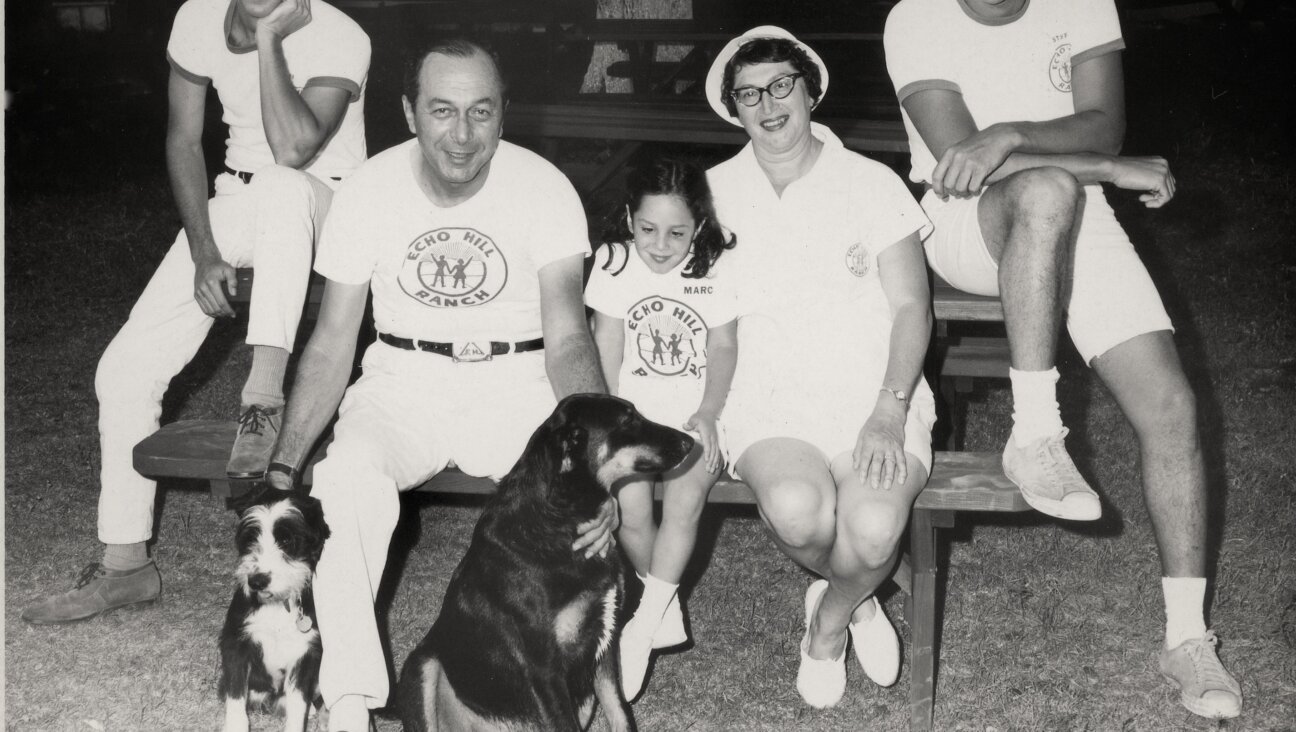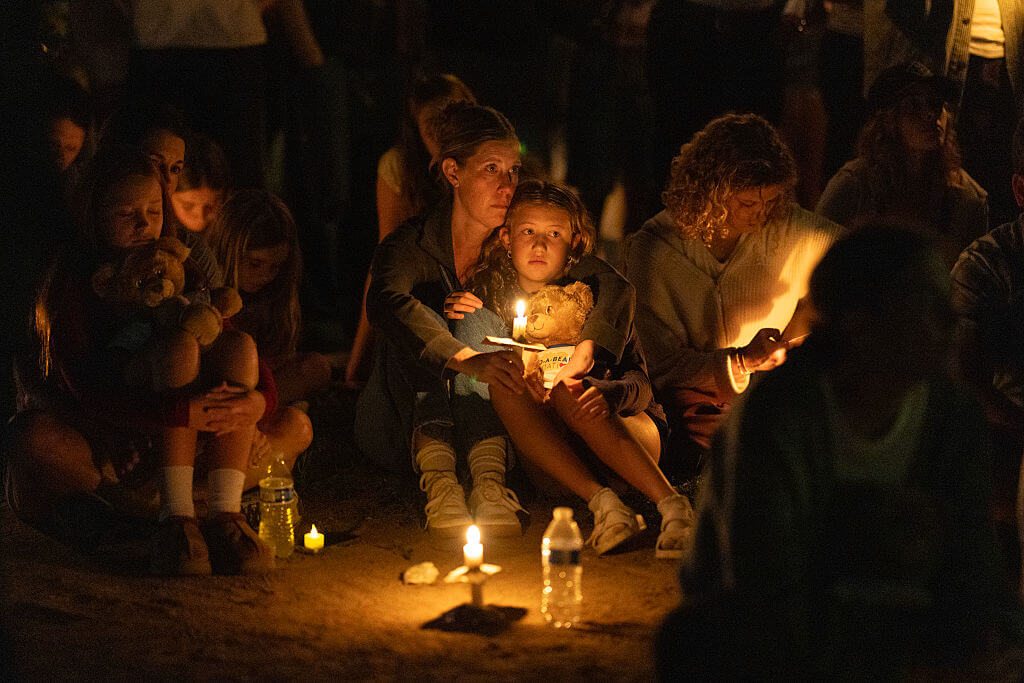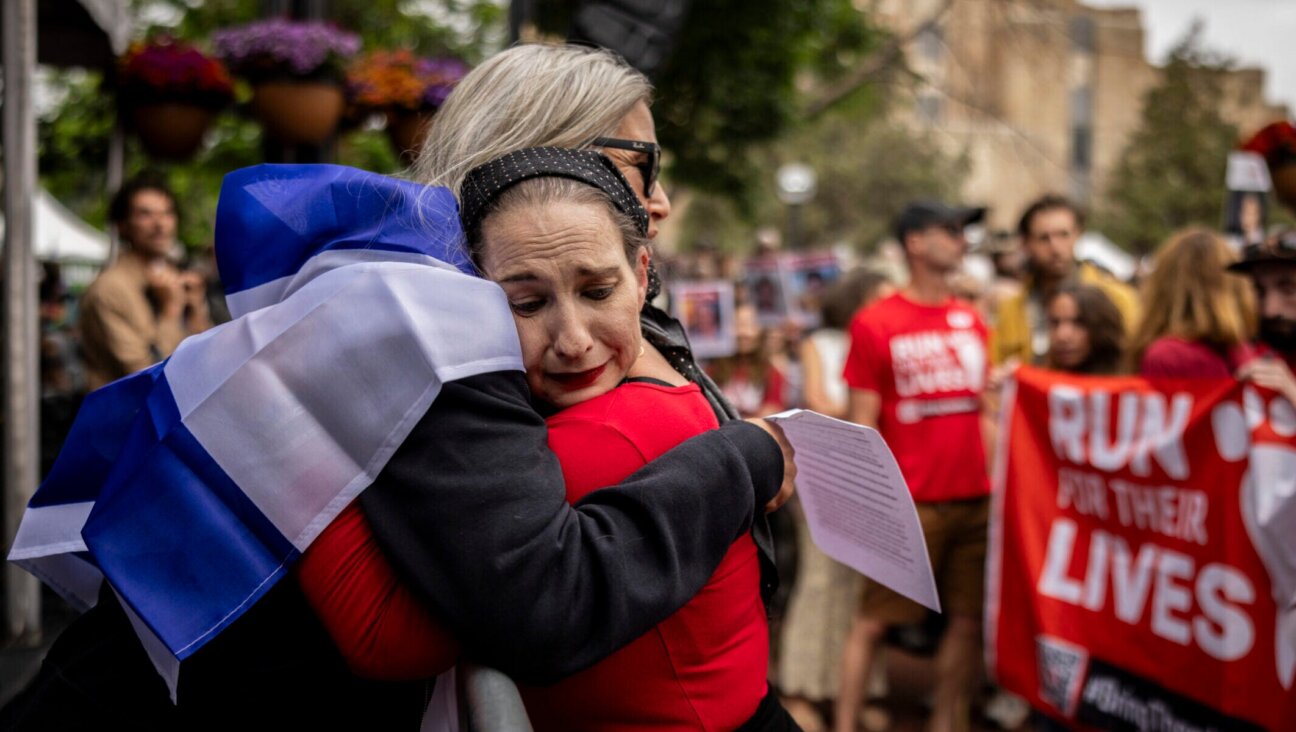Boston’s Vilna Shul Connects Present With the Past

Graphic by Angelie Zaslavsky
On a Sunday morning in late November, around 250 people fill the dark brown wooden pews of the Vilna Shul in Boston. A synagogue built by Jewish immigrants from Lithuania in 1919 on Phillips Street in the central Beacon Hill neighborhood, it closed in 1985, and then reopened as a cultural center in the early 1990s. With its wooden floors, narrow ceilings on the first floor, and partly recovered murals and stained-glass windows in the sanctuary on the second floor, the building feels old, and full of history. But today, there’s a touch of summer camp.
Every person is wearing a white nametag. Some carry large white signs with surnames on them: Flink, Goldstein, White. Marilyn Okonow, a slight woman with dark curls tinged with grey, is standing on the central bimah, and calls out the family names on the nametags. Members of the audience cheer.
What’s happening here? On the surface, it is a very well-executed event that connects people to the Vilna Shul while preparing for a capital campaign to complete the renovation of the building in time for the 2019 centennial. What the people munching on bagels and fruits have in common is that their ancestors were founding members of this Orthodox congregation. Names of those members appeared on one of four plaques, which were the only surviving record of the early members. Okonow and David Rosen, both of whom are board members and genealogists, teamed up to painstakingly research about 60 of the more than 400 names — and brought around 350 people to two Descendants’ Day events. (The first took place in November 2013, the second one year later.)
But there’s something else going on. “We’ve hit on something,” Okonow had told me on the phone a few days earlier. She has been inundated with requests from people who had a connection with the shul over the past year. “People really want to know about their roots.” The past few decades have seen an increased interest in genealogical research; Okonow is part of this trend.
A trained musician and former stay-at-home mother, Okonow traced her own ancestors back to the Pale of Settlement in imperial Russia as well as Galicia in the former Austro-Hungarian Empire (“My mother said they were from Vienna. They weren’t from anywhere close to Vienna… Maybe my mother just assumed that, or they wanted to be highbrow,” she said.) Having always been involved in the Boston Jewish community, she joined the board of directors of the Vilna Shul (the official name is Vilna Shul, Boston’s Center for Jewish Culture) in mid-2012.

All the Shul’s Men: Visitors taking photos of the Men’s Wall, which dates from 1923. Image by Sandy Swartz
Soon after, the four plaques, containing a total of 454 names of what were presumably the founding members, grabbed her attention. The so-called Men’s Wall, on the back wall of the sanctuary on the second floor, is the largest. It dates from 1923, and contains around 150 to 200 names. There are also three plaques with women’s names, commemorating the “Ladies’ Auxiliaries” dating from the years 1907, 1923 and 1936. When Okonow asked if anyone had tried to find out what happened to these people, Rosen, a retired engineer who single handedly indexed all obituaries and wedding announcements from the Jewish Advocate of Boston published between 1905 and 2008 — a total of more than 50,000 entries — said that he had tried 15 years earlier but with little luck. But he was on board to help with another attempt.
Having transliterated the Hebrew letters on the plaques and figured out what the right vowels were, some of the challenges the pair faced included tracking the former members in public records, such as census data, birth, marriage and death certificates, ship manifests, naturalization documents, and drafts from World War I; determining if and how the surnames changed after they arrived (many immigrants switched to more American-sounding surnames once they had settled, and women typically changed their last names as they got married); cold calling the descendants and getting them to stay on the phone long enough to tell them that they had found information about their ancestors and weren’t soliciting money (yet).
“There’s definitely a treasure hunt aspect to it,” said David Laskin, author of “The Family,” in which he researched the story of his family in Eastern Europe, Israel and America. Genealogical research requires patience and can be painstaking. “They love challenges,” said Schelly Talalay Dardashti of her fellow genealogists. The U.S. genealogy advisor for MyHeritage.com runs the Jewish genealogy blog Tracing the Tribe (currently on hiatus) and its 6,400-member-strong Facebook group.
“There is more online now than there ever was,” said Dardashti, adding that she “almost went blind on microfilm” when she started researching the history of her own family (which has Sephardic roots in Spain) a few decades ago. The Internet has made research across national borders or long distances easier. In addition, as Dardashti puts it: “If it’s accessible and you can do it from home in your bunny slippers and your jammies, you are more apt to do it.”
It’s often the grandchildren of immigrants who dig into the research, so they are usually — temporally and thus emotionally — removed from the most traumatic parts of the family history. Those who came to America from Eastern Europe between roughly 1880 and 1914 were not only too busy with establishing a livelihood, but also keen to Americanize. “My grandparents were like, ‘We left, why would you want to think about it? They hated us; it’s better here,’” said Laskin. “In many ways they’re right, but it’s also [that] these are our roots.”
“People now have time to look back,” Dardashti said. “You can think about who were the people that got you here.”
In the case of the Vilna Shul community, Okonow and Rosen have unearthed stories of the poverty, tragedy and success that come with immigration. Boston, as Ellen Smith, a historian at Brandeis University and co-editor (with Jonathan Sarna) of the 2005 book “The Jews of Boston,” explained at the November event, has a “goofy” Jewish history. Jews came to the city relatively late, in the mid-19th century, and most were Central and Eastern European immigrants. By 1920, the Jewish population had increased to 80,000, accounting for 11% of the population.

The Vilna Shul in Boston Image by Wikimedia Commons
The few blocks around Cambridge Street on the north slope of Beacon Hill — where the Vilna Shul is located — and the West End soon became the principal stronghold of the Jewish community, effectively pushing out a vibrant abolitionist and black middle-class community, “the heart of free black America,” as Smith calls it. For example, one group of Lithuanian Jewish immigrants calling themselves Anshe Vilna (“people of Vilna”), who had prayed together since 1893, bought a Baptist Church on 45 Phillips St. in 1909. They used as a synagogue for 10 years until they built the Vilna Shul on 18 Phillips St., where it still stands today. Today, the Black Heritage Trail, a walking tour, goes through Phillips Street, where two sites, the former home of Lewis and Harriet Hayden, who escaped slavery in Kentucky, and the house of abolitionist John Coburn, both of which were part of the Underground Railroad, are located.
Life must have been crowded, noisy, smelly, poor — and argumentative. In the early 1900s, there were 42 Jewish congregations in the West End; many people belonged to more than one synagogue. “There were good fights over dinner,” according to Smith.
No matter how poor and hard the lives of their ancestors might have been, those who have come to the Vilna Shul are very excited to learn more about them. After an hour and a half of speeches, some gather in front of the mural (which depicts temples in ancient Palestine and was restored through a $90,800 grant from American Express and the National Trust for Historic Preservation in 2009) for family photographs. They try to squeeze up to 18 people in a group shot, while others rustle the documents Okonow gave them.
Two middle-aged women approach me, one holding a golden candelabra (a gift from the shul to her grandfather); my follow-up questions lead to an animated discussion of who is related to whom. (“Don’t listen to her,” one says.)A mother and daughter couple tells me that they used to own two buildings on Irving Street, around the corner from the shul. Do they still own it? “I wish we did. It would be worth a fortune.”
While some had always been aware of their family’s connection to the Vilna Shul, others were taken by surprise. “I knew that he was a rabbi in Boston,” said Nina Kallen, an attorney in Boston, stressing the “a.” She was talking about her great-grandfather Jacob David Kallen, who was the rabbi of the Vilna congregation in the 1880s and 1890s, before it moved to the present building.
And then there were those for whom Okonow’s joke struck home: “In some ways, David and I know more about your family than you do.” Take Minnie Fishman, who was born in what was then Galicia, and came to Boston in 1897 in her early 20s. She soon married a Russian immigrant called Jacob Fishman, had a daughter, Jennie, in 1902, twin boys Abraham and Benjamin a year later, and another son, called Nathan, in 1905.
In 1907, Jacob Fishman died at only 40 years old of a cerebral hemorrhage, leaving Minnie Fishman on her own with four children under the age of 5. The 1910 census indicates that Minnie Fishman moved to Malden, a town north of Boston — with only one child, her daughter. Rosen dug up records about the boys: Probably desperate, the widowed mother placed the twins in a Jewish orphanage in Mattapan, and Nathan in a foster home in Newton.
“I did not know that Uncle Bennie and Uncle Al were separated from their mother,” said Stanley Steinberg, 64, who fondly remembered his grandmother Jennie, a homemaker all of her married life. The story has a happy ending: In 1920, Minnie Fishman managed to reunite her family in an apartment on 86 West Cedar St. in the Beacon Hill neighborhood, a few blocks away from the Vilna Shul. Jennie Fishman, 17, worked in a toy store (Steinberg said he didn’t know that, either), 16-year-old Abraham Fishman was an errand boy at a hat shop, and his brother Benjamin Fishman was the office boy of a lawyer. Minnie Fishman was part of the Ladies’ Auxiliary of the Vilna Shul; her name appears on the 1923 plaque.

A New Community? Fundraising has increased since the first Descendants’ Day in 2013, and the Vilna Shul hopes to complete renovations by 2019. Image by Mara Brod
By the mid-1900s, many Jews had left the West End for Boston’s suburbs, and a controversial urban renewal project in the late 1950s turned the neighborhood of three-to-five-story buildings and narrow streets into a mixed-use commercial and residential area with high-rise apartment buildings. The change in scenery on the other side of the busy, multi-lane Cambridge Street is abrupt. The brick sidewalks, gaslit lanterns and Federal-style houses of Beacon Hill are gone. “It used to look like Beacon Hill,” Rosen tells me.
The Vilna Shul might not have its community anymore, but it is building a network of people who feel connected to it. When I asked Barnet Kessel, the executive director, if fundraising had increased since they first reached out to descendants more than a year ago, his reply came without hesitation: “Absolutely.” He stressed that this wasn’t the goal of connecting. Still, since the Vilna Shul is preparing to complete the restoration of the building and make it fully accessible by the centennial in 2019, it doesn’t hurt to get the word out. And this might not even require that much more digging, according to Okonow: “It is going to get a life of its own.”
Which is what a community is all about.
Anna Goldenberg is the Forward’s arts and culture fellow.



